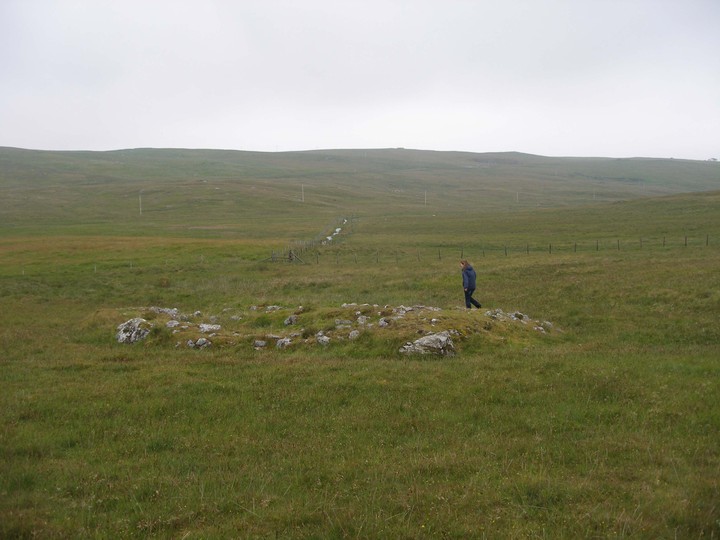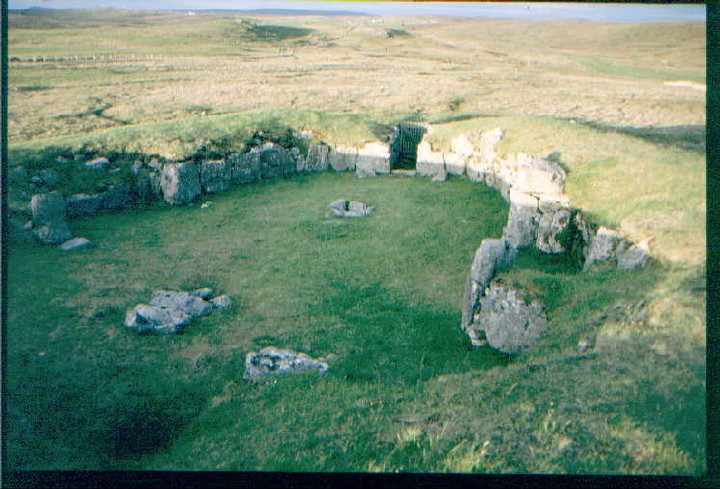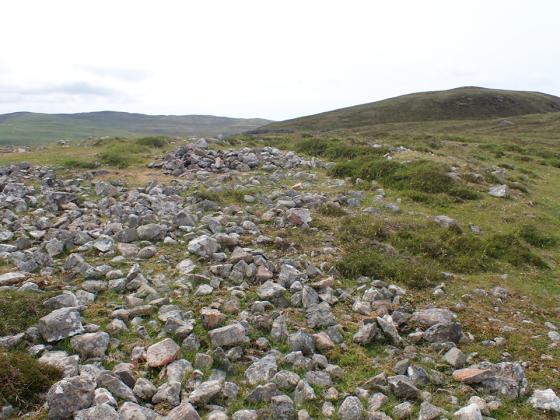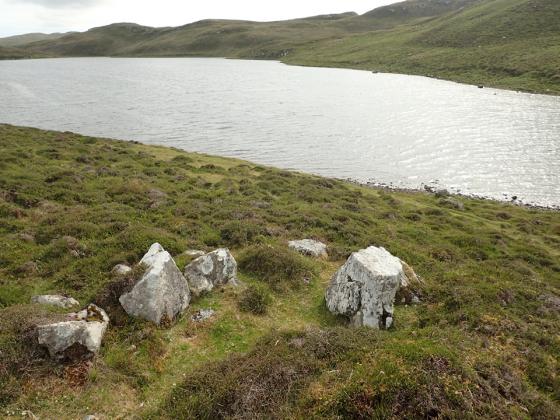
24/09/2014 – Stanydale Temple’s fantastic concave facade

24/09/2014 – Stanydale Temple’s fantastic concave facade

24/09/2014 – Group of stones next to Stanydale Temple. Looked a bit random in placement now.

24/09/2014 – Lovely Neolithic house on the way to Stanydale Temple.

Photo taken 11th May 2014. The well kept interior of Staneydale Temple.

Photo taken 11th May 2014. Amazing mosaic effect on the stones at Stanydale.

Photo taken 11th May 2014. Storm clouds starting to mass over Stanydale The stones in the centre of the shot are the remains of the posthole.

Photo taken 11th May 2014. What remains of the arc of standing stones around the ‘temple’.

Photo taken 11th May 2014. Stanydale Temple and information board.

Remains of neolithic house close to Stanydale temple


Stanydale meeting house / temple



24/09/2014 – Visited after Scord of Brouster at the end of a long day out. The sun had done a runner and I was tired, so was not much in the mood to look around. The Neolithic house soon cheered me up a little, great bonus on the way to Stanydale Temple. I liked the windbreak on the front of the house. Then just a short walk on to Stanydale Temple. The building is impressive. I think I liked the outside walls more then inside the ‘temple’. The concave facade is fantastic and reminded me of a few of the chambered cairns I have seen this week. Great site with lots to see. I need to go back when it’s sunny and I’m more awake.
Visited 11th May 2014
This was near the top of my list of must visit places on Shetland, and with the sun making an appearance through the clouds, bringing some warmth to the day, and our time left on Shetland fast diminishing, we headed for Shetland’s ‘wild west’ and the enigmatic Stanydale.
On what felt like a road to nowhere a sign and parking spot soon makes itself visible, and we squeeze the car into the layby. It feels remote here, and is one of the few places on Shetland where we’re not able to see the sea.
Setting off across the slightly squelchy moorland it’s not long before we arrive at the Neolithic house not far from the temple. Like Carl before us we sit in the remains of this ancient dwelling, and just take in the atmosphere. Cracking open the Thermos we have a cup of tea, drinking in the peace and quiet as much as the PG Tips, and wondering what the venerable farmer who constructed this place would have thought about a pair of visitors supping tea in his house some four millennia later?
As we press on for the temple, shadows from the clouds and ever changing light play across the heath and with only the lonely cries of birds as a soundtrack we feel as if we’ve stepped into another world. Soon the structure of the ‘temple’ is visible, the small wooden gate guarding the entrance opening into a well-kept interior, the grass mown to a standard that wouldn’t look out of place on the greens of a championship golf course.
It’s certainly an unusual place. Thick stone walls delineate a horseshoe shaped building, which apparently, according to the conclusions of an excavation in 1949, was similar in size and plan to temples found on Malta, hence leading to Stanydale’s ‘temple’ epithet. Inside the enclosure the large stones which make up the walls are chunky blocks, rare in this vicinity, and so again according to the 1949 dig, must have been brought some distance, a lot of trouble to go to if it was purely meant as a domestic structure perhaps, as there are plenty of suitable other types of stone for building nearby. Looking closely at the large upright stones as well I’m struck by the natural patterns on them, different coloured shapes on the stone caused by lichens giving a mosaic like effect. There are also two large postholes inside, from which charred spruce was found, the nearest source of which in Neolithic times would have been Scandinavia, unless of course they were found as driftwood?
I have a wander around the exterior, taking in the standing stones which are dotted around the perimeter of the temple. There appears to be a defined arc of stones to the south, perhaps the structure was once surrounded by them, but now it’s difficult to make out the overall layout of the stones.
Sitting back inside Stanydale to write my notes I’m struck but what a strange and unique place it is. It seems much more than just a grand dwelling, or even a fancy ‘village hall’ type of meeting place, something about its layout, the exterior stones, and three fire hearths (which again according to the excavations were not typical of domestic settings). It strikes me that I’m reminded of the main structure at Barnhouse, near Stenness on Orkney, where I was sitting only a week ago. Although the design of the two structures are very different, something about them feels the same, and I’m convinced this place had a ritual function, an old cliché I know, and based on little more than my own ‘feelings’ of the place and some sketchy evidence (no wonder I never got that Archaeology degree!)
What I can say with certainty is that Stanydale is most certainly a great place to visit. It feels both remote and welcoming, certainly unique, and a perfect place to spend some time, sheltered here from the wind, with the sun overhead, we just don’t want to leave. Magical.
Visited 14.6.12
This is a great place to visit!
The site is sign posted and has a parking area.
The sign states it is a 1½ mile walk – it’s not – it’s about half mile and only takes 15 minutes to walk to the site along the ‘path’ through the fields. You have to cross over a small burn.
It was a pleasant walk in the sunshine with only birdsong for company.
It wet weather this would be a very boggy walk so be prepared.
Before getting to the ‘Temple’ I was surprised to come across an information board and a Neolithic house! I sat inside, out of the wind. It was amazing to think that I was sat in someone’s house from 4,500 years ago!
Another surprise was the ‘standing stones’ either side of the ‘Temple’.
These are mentioned on the notice board near the ‘Temple’.
There are 5 stones on the left – forming a rough circle? – the tallest about 1.5m high and covered in ‘hairy’ lichen.
There are 10 stones to the right – a ‘mish mash’ with no obvious shape to them
As for the ‘Temple’ itself it is in very good condition although no doubt restored.
Access is through a small wooden gate.
The wide walls are about 1.5m high and topped with turf.
The inside measurement of the ‘Temple’ is about 5 metres x 10 metres.
In the middle of the room are two stone lined holes which once held wooden posts to support the roof.
I sat inside and tried to contemplate its meaning?
It is an odd place as the walls seem too wide to be domestic – certainly disproportionate to the inside measurements. But there again maybe someone wanted a super strong house?
After all, the much more recent Black Houses have disproportionately wide walls.
Either way, this is a great place to visit and it is certainly an unusual building.
It was no surprise that I had the place to myself as it does feel quite remote when you are here.
The clouds have gathered and it is starting to rain. Time to walk back to the car.
If you ever get the chance, visit this place. You won’t be disappointed.
The site is reasonably well signed from some way off, but the only parking is what looks like a passing place. We went past this thinking that there would be a bigger spot, and its a long way before you can turn round!
Its about 10-15 minute walk to the site from the parking area. Route is well marked with posts and signed. Interpretation boards en route at other landscape features.
Terrain is quite boggy moorland and there could be a midge issue at times.
The site itself is best described as enigmatic. Not clear what it was, and why very unusually for Shetland the sea is not visible.
Many other prehistoric remains in the vicinity.
Stanydale’s magnitude, awe inspiring. when we visited a few days ago we froze in snow and wind, today the sound of the winds merely a pleasant backdrop as I lie in the grass in here, the clearest blue sky overhead and a bright afternoion sun. the walls are built from stocky boulders, and smooth, mostly; they walls feel so rigid; and upto about 15’ thick. they were certainly meant to remain. so many stones must have been moved to make this place. I marvel at the thought of the same building perhaps being used for two thousand years.
(its a shame the entrance has been bastardised with a wooden gate).
collections of standing stones, one lot at each side, aligned, only one of which is in a circular shape.
apart from, like, StoneHenge and Avebury, one of the grandest sites I’ve been to (but I haven’t been to many)
-Stanydale ‘temple’, 15 March 2002













